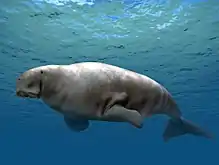| Protosiren Temporal range: [1] | |
|---|---|
 | |
| Drawing of skeleton | |
| Scientific classification | |
| Domain: | Eukaryota |
| Kingdom: | Animalia |
| Phylum: | Chordata |
| Class: | Mammalia |
| Order: | Sirenia |
| Family: | †Protosirenidae |
| Genus: | †Protosiren Abel, 1904 |
| Species | |
| |
Protosiren is an extinct early genus of the order Sirenia. Protosiren existed throughout the Lutetian to Priabonian stages of the Middle Eocene. Fossils have been found in the far-flung locations like the United States (South Carolina,[2] North Carolina and Florida[3]), Africa (Egypt), Europe (France, Germany and Hungary) and Asia (India and Pakistan).
So far, five species have been named. From comparative anatomy and chronological order,[4][5] it has been suggested that P. fraasi, P. sattaensis and P. smithae represent an ancestor-descendant lineage.[5] P. eothene is the oldest and smallest species.[6]
Ecology

Like the extant sirenians (manatee and dugong), Protosiren is thought to have fed on sea grasses as well as freshwater plants. Unlike extant sirenians, Protosiren had hind limbs. Although the limbs were well-developed, they were small and the sacroiliac joint was weak. Consequently, Protosiren is thought to have been only or primarily aquatic, rarely venturing on to land.[7][8] It has been speculated that it swam by caudal undulation and used its hind limbs to crawl along sea floors in nearshore habitats while feeding. It might have occupied a different ecological niche than the contemporary Eotheroides, which had a closer resemblance to modern sirenians.[7]
See also
References
- ↑ Díaz-Berenguer, Ester; Badiola, Ainara; Moreno-Azanza, Miguel; Canudo, José Ignacio (2018). "First adequately-known quadrupedal sirenian from Eurasia (Eocene, Bay of Biscay, Huesca, northeastern Spain)". Scientific Reports. 8 (1): 5127. Bibcode:2018NatSR...8.5127D. doi:10.1038/s41598-018-23355-w. PMC 5865116. PMID 29572454.
- ↑ Beatty, Brian L.; Geisler, Jonathan (2010). "A stratigraphically precise record of Protosiren (Protosirenidae, Sirenia) from North America". Neues Jahrbuch für Geologie und Paläontologie - Abhandlungen. 258 (2): 185–194. doi:10.1127/0077-7749/2010/0095.
- ↑ Bryan, Jonathan R., Scott, Thomas M., Mean, Guy H., 2008. Roadside Geology of Florida. Mountain Press.
- ↑ Gingerich P.D., Arif M, Bhatti M.A., Anwar M & Sanders W.J. (1997). "Basilosaurus drazindai and Basiloterus hussaini, New Archaeoceti (Mammalia, Cetacea) from the Middle Eocene Drazinda Formation, with a Revised Interpretation of Ages of Whale-Bearing Strata in the Kirthar Group of the Sulaiman Range, Punjab (Pakistan)". Contributions from the Museum of Paleontology, University of Michigan 30(2): p. 55–81
- 1 2 Gingerich P.D., Muhammad A, Bhatti M.A., Raza H.A. & Raza S.M. (1995). "Protosiren and Babiacetus (Mammalia, Sirenia and Cetacea) from the Middle Eocene Drazinda Formation, Sulaiman Range, Punjab (Pakistan)". Contributions from the Museum of Paleontology 29(12): p. 331–57.
- ↑ Zalmout I.S., Ul-Haq M. & Gingerich P.D. (2003). "New species of Protosiren (Mammalia, Sirenia) from the early middle Eocene of Balochistan (Pakistan)". Contributions from the Museum of Paleontology 31(3): p. 79-87
- 1 2 Zalmout I.S. & Gingerich P.D. (2012), “Late Eocene sea cows (Mammalia, Sirenia) from Wadi al Hitan in the western desert of Fayum, Egypt”, University of Michigan Papers on Paleontology No. 37
- ↑ Berta, Annalisa, 2017. Rise of Marine Mammals: 50 Million Years of Evolution. Johns Hopkins University Press.
- Domning, D. P.; Morgan, G. S.; Ray, C. E. (1982). North American Eocene sea cows (Mammalia: Sirenia). Smithsonian Contributions to Paleobiology Number 52. Smithsonian Institution Press, Washington, D.C.
External links
